Rosewill Blackhawk Ultra Case Review: Were It Not For Competition
by Dustin Sklavos on March 28, 2013 12:01 AM EST- Posted in
- Cases/Cooling/PSUs
- Rosewill
- HPTX
- ATX
- XL-ATX
Noise and Thermal Testing
When I saw the Rosewill Blackhawk Ultra lacked a fan controller, I immediately became much more skeptical about its performance. Thermally it should do a stellar job, but with no way to modulate fan noise, Rosewill basically has to count on the fans being quiet at stock. An integrated fan controller is practically essential at this price point, so they have to make up a lot of ground to be competitive.
Unfortunately things get a bit worse here, too. The Phantom 630 (which earned our Bronze Editor's Choice) is sitting at the exact same price point, and if you're not running bigger than XL-ATX, NZXT's vastly more feature rich enclosure may prove to be a very difficult competitor to beat.
Ambient temperatures during testing were almost 22C on the dot.

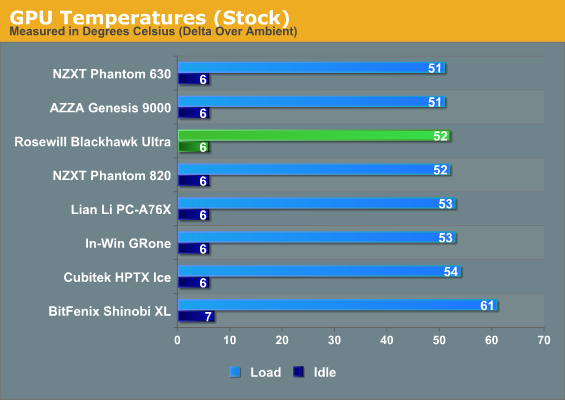
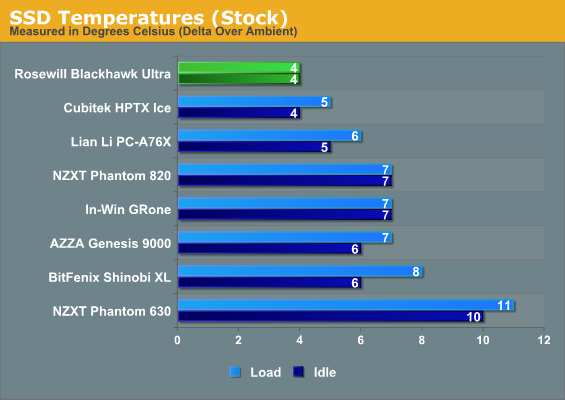
At our stock settings, Rosewill's offering is at least able to put up the thermal performance it needs to in order to be competitive. It's unlikely anyone using this case will run their hardware at stock, but it's good to know the cooling capacity is definitely accounted for.
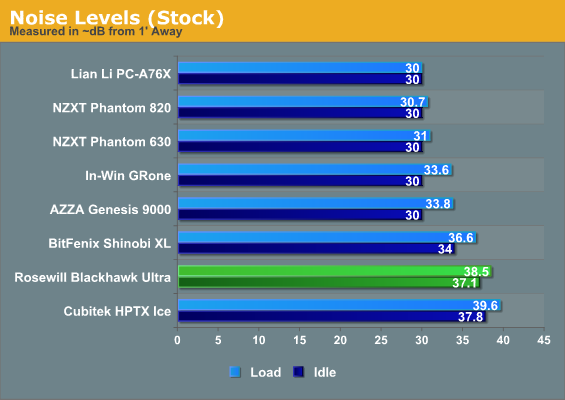
Unfortunately, noise levels turn out to be a real issue. In the Blackhawk Ultra's defense, while the measured 37.1 dB of idle noise is pretty loud, the character of the noise is actually pretty tolerable. It's very low-pitched due to the size of the fans used; the case essentially sounds like a box of low wind. NZXT's Phantom 630 runs a lot quieter, though, with only a minor three degree uptick in CPU temperatues.
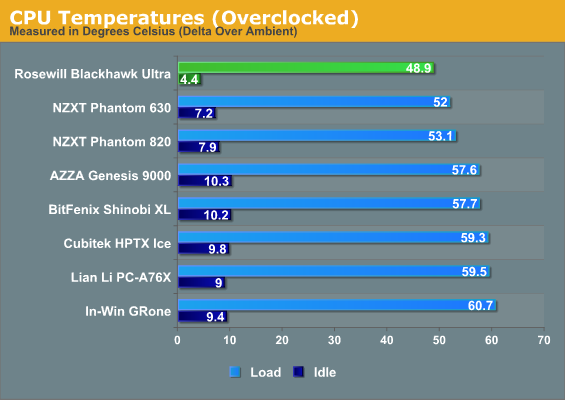

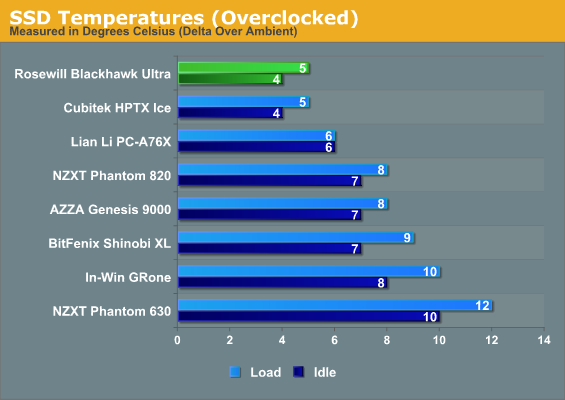
Overclock the system and temperatures begin to compress a little, but Rosewill also continues to perform near the top.
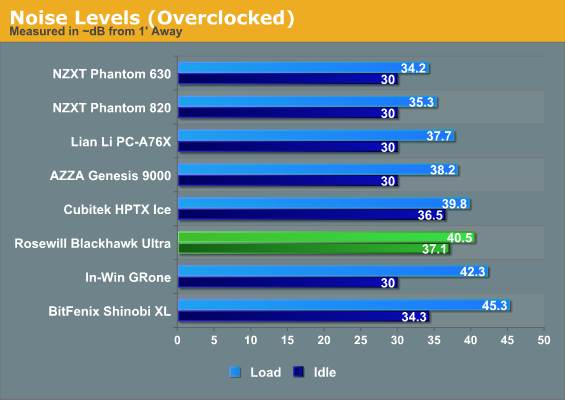
Despite its excellent airflow, though, Rosewill just can't keep the noise levels down. A large part of that is simply due to the fact that the case's noise floor is 37.1 dB, loud enough to drown out most of the other components in the first place.
Unfortunately I don't have results for the NZXT Phantom 630 in our full fat testbed, where I do think the Blackhawk Ultra promises to acquit itself better. The only cases I've tested so far with that testbed are in different price brackets, but this should at least illuminate why spending more on a case isn't a bad idea if you're going for a high end build.
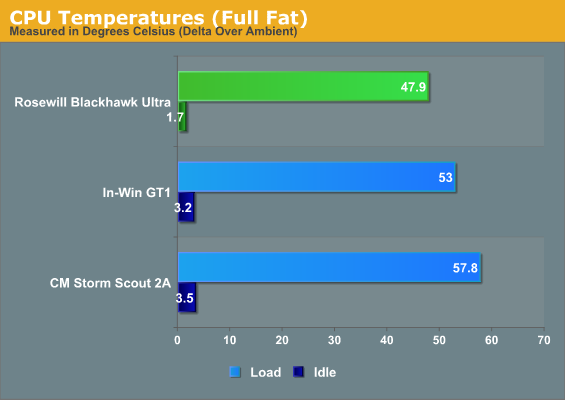
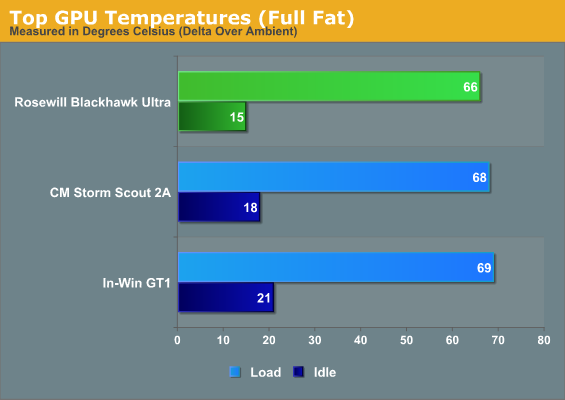

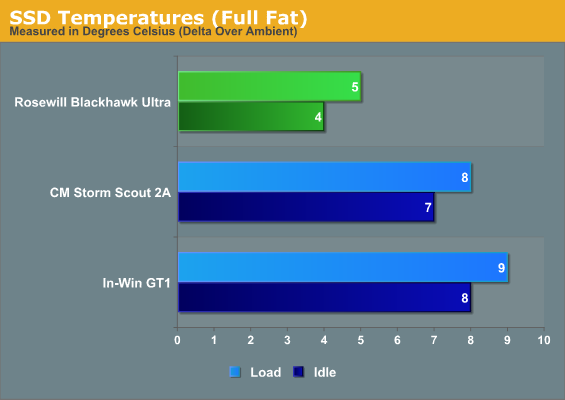
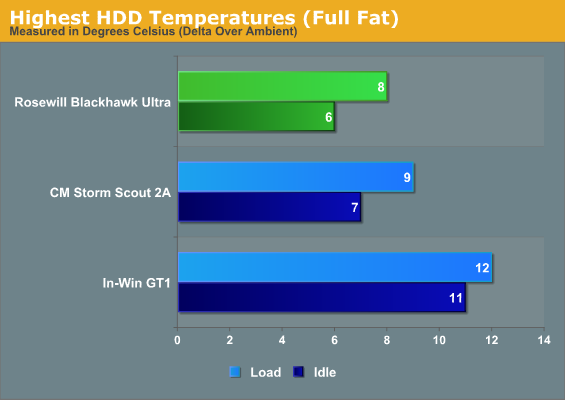
Rosewill's case gets you a not-inconsiderable five degree delta over the In-Win GT1 on the CPU, and GPU thermals are also down by a couple of degrees. In an SLI configuration, the GeForces are going to be pushing their fans to hit a target temperature of 88-90C, so thermals in that instance won't be as telling as noise levels will be.
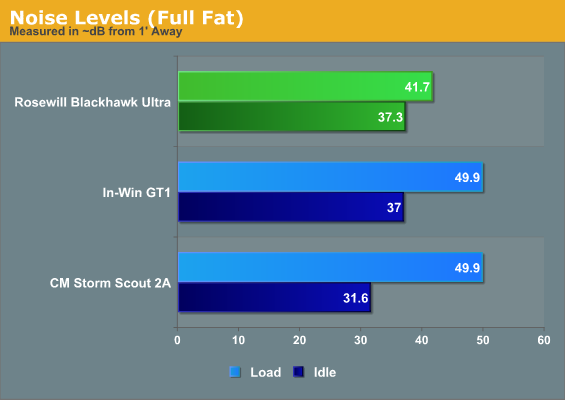
And here's Rosewill's ace in the hole. While idle noise is still unpleasant, load noise is worlds better than the competing cases. This is why you buy an enthusiast class case for a high end build; the superior airflow keeps the fans on the GeForces from having to go at full tilt, and as a result, the noise level is actually comparatively tolerable.










27 Comments
View All Comments
lwatcdr - Friday, March 29, 2013 - link
You see I feel the opposite. I would like to see more cases with just optical drive bays. It is easy enough to put in adaptors for any drive you want. What I really want is an ITX or mATX case with just 4 optical bays. I can get two 2to3 hotswap bays and make a NAS then. I would take six bays as well as then I could use two 3x5 bays and build a 10 drive NAS. In a way I do agree that we need more extreme cases. I would like to see some with no optical bays, some with only optical bays, and some with a mix of bays.lwatcdr - Thursday, March 28, 2013 - link
I do not think that the Blackhawk competes with the Phantom 630 but with the 820, the Switch 810, and other cases that support E-ATX and larger motherboards. The 630 is a great case but is a good bit smaller. If you want to do a build a really complex water cooler loop system, or run a quad SLI system then you need a case like the Blackhawk. The 630 is a great case but not really in the same class as the Blackhawk. The Switch is and frankly maybe the better case for a lot of builds.The one place that Blackhawk and it's twin the Xigmatek Elysium really shine is if you want a dual CPU workstation. They have the cutouts to support dual CPUs. That is also probably why they have such conservative looks. If you are going to build a dual 2011 system with a Quadro card and maybe a Tesla card or two then you really don't want it to look like a transformer. Lots of space and cooling for a really large system for a really low price.
SunLord - Thursday, March 28, 2013 - link
I have this case which I'm setting up to run a water cooled Dual Opteron server. This case is perfect for crazy large water cooled builds. As you can easily run 1 200MM on top, 1 3x140mm on bottom, and 1 140mm radiator on the rear with little trouble. You also can in theory fit in a 2x140MM radiator on the side of the hard drive cage but it's a bit of a pain as the case isn't meant mount one there. You also have the option given all the hose holes to use external radiators.JonnyDough - Friday, March 29, 2013 - link
Honestly, two big fans directing air through filtration from bottom to top is all you really need to properly cool a case. I still think that the modern redesign of the old layout has a long way to go. How these companies situation the goods inside the case could use some re-evaluation.It would be best served towards the front bottom of the case, below the drives for cable routing. The PSU needs to be a source of filtered cool air INTAKE. The out other intake needs to be filtered air through the bottom rear of the case flowing directly into the video card. If you want, an optional third intake can be window mounted with direct ducting to the CPU cooler.
The top of the case needs one giant quiet fan in the middle to expel hot air. Hot air rises, so it will rise to the top naturally and be expelled from the case by the fan. Positive air pressure is not necessary as long as the rest of the case is sealed up and the only intake possible is through the filters.
lwatcdr - Friday, March 29, 2013 - link
I think you underestimate the value of positive case pressure.1. It is pretty impractical to seal a case so it can only intake air from filtered sources. USB ports, side panels, and other ports and connections are almost never air tight.
2. Higher air pressure means that you have denser air which means more mass to carry away the heat. Of course just to make life hard when you compress a fluid like air you heat it. Light positive pressure supplied from filtered intakes.
sulu1977 - Friday, March 29, 2013 - link
What I want to see is a case with a filter so that no dust or insects can get inside. Also most of USB ports should be at bottom of front panel, behind a simple hinged cover.Ammohunt - Thursday, April 4, 2013 - link
I would like to see this case built with every fan position filled.